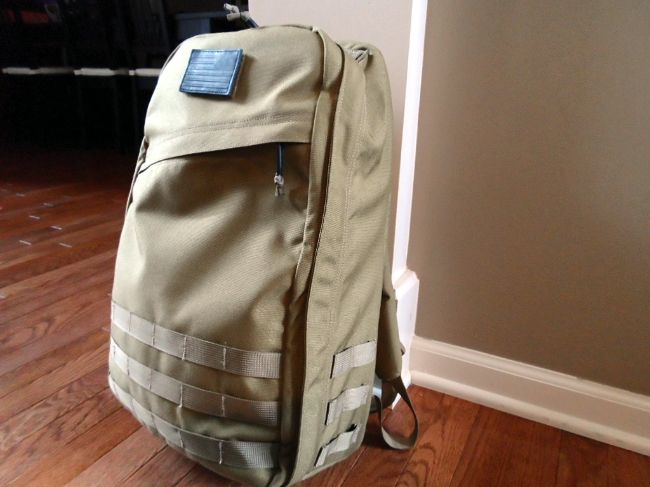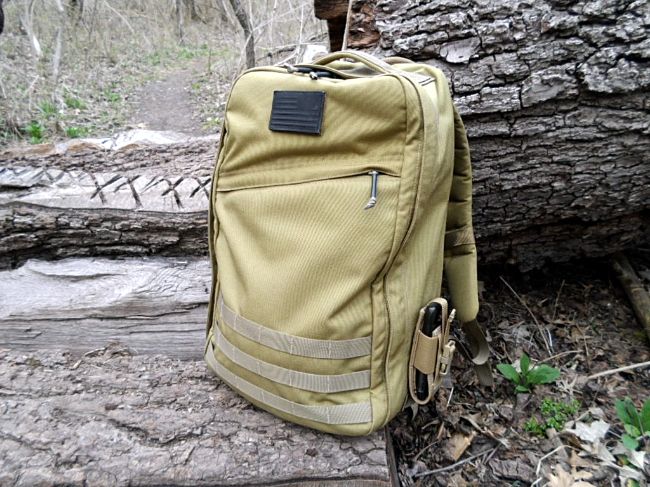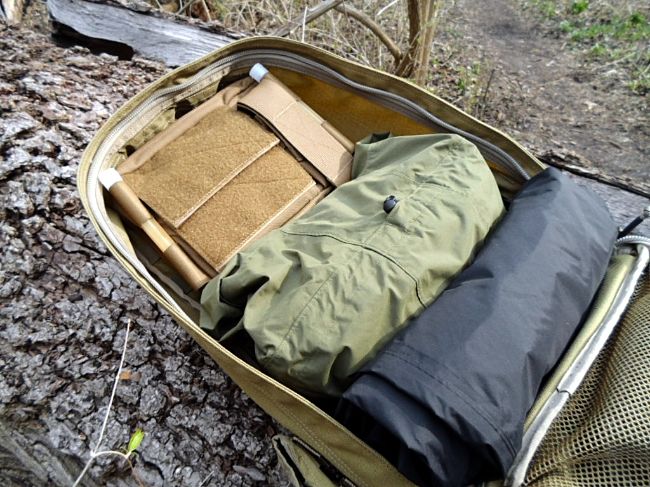GoRuck, as a company, is hard to pin down and maybe Jason McCarthy, the company’s founder and former Army Green Beret, likes it that way. Since it’s inception in 2010, GoRuck has grown from a gear and clothing manufacturer into a lifestyle and fitness company that sells gear. I get the feeling from reading Jason’s posts on the GoRuck blog that this was the plan all along. That isn’t necessarily a bad thing but grasping the company’s mission is key to understanding it’s design philosophy. And it’s flagship product, the one that they brought to the dance, is the GoRuck GR1 backpack.

The GoRuck GR1 backpack
I’ve been carrying the GoRuck GR1 for about two months now. Originally, I was looking for a rugged military inspired backpack to use for day hikes and other outdoor activities but could also be pressed into regular Every Day Carry (EDC) duty if needed. That’s important to note because it’s the lens that I’m looking through when evaluating the GR1 – your philosophy of use may vary. You’ve probably already read GoRuck’s GR1 Explained and therefore you are not going to find that detail repeated here. If you haven’t, then go and spend the time. As far as I’m concerned, it’s required reading for anyone considering an investment in a GoRuck pack.
Exterior Design
At 26 Liters/1,586 cubic inches in volume, the GoRuck GR1 is the perfect size for a day pack. The exterior is largely “slick” with a minimal amount of PALS webbing. This doesn’t allow as much flexibility to attach external pouches and accessories but the pack is less military looking making it an appropriate carry option even in some office environments.

The front of the GoRuck GR1 has one large external slash pocket. As mentioned in GR1 Explained, when the bag is full, the pocket is compressed restricted it’s volume and the user’s ability to access it’s contents. I found it useful for small items but not much else when the pack was full. I’ve attached to the velcro panel GoRuck’s cool Leather Flag Patch. GoRuck was the first company that I know of to create quality leather morale patches and they come in a few different colors and designs. I hope they create more.
The pack pictured is GoRuck’s limited edition Coyote. The last sprint run was in March and it is no longer available for sale on their website (in my opinion, it should be a standard color). Future sprint runs are planned including Desert MARPAT and Foliage Green.

The GR1′s 1000D Cordura fabric is fairly coarse (even compared to other 1000D packs I’ve reviewed) and they used it for the entire exterior of the pack – including the back of the pack straps and the back panel, which coincidentally are the parts of the pack that most frequently come in contact with the user. That’s great for durability in those high wear areas, but unless you’re wearing an outer layer, the material just doesn’t feel very good when you’re wearing just a t-shirt. On top of that, the straps are pretty stiff out of the box and take a while to break in (especially if you’re not using it for a Challenge). And the cells on the back panel aren’t raised enough to provide good cushion and air flow to prevent “soggy back syndrome”. These are issues which are pretty easy to address with the selection of different materials – smoother nylon for the contact areas and raised Dri-Lex Aero Spacer mesh or a similar material for the back panel.
Despite the rough treatment they deliver, the GR1′s beefy Cordura straps do handle a heavy load out better than any other pack of this size I’ve carried to-date. In that regard, the design works as advertised.
The only other issue I have with the exterior of the pack is the lack of a sternum strap. I added a sternum strap to the GR1 but at the price point it should definitely be included. Heck, it was even mentioned in the GR1 Explained (back in January 2011) as an accessory in development. How hard can it be to make a sternum strap?

I attached two pouches to the side MOLLE webbing. A TAD Gear iComm pouch for my camera…

and a Maxpedition 5″ Phone Holster for my Smartphone. Both khaki’s match up well with GoRuck’s Coyote (especially the TAD khaki), which is good since GoRuck hasn’t yet offered small accessory pouches for their packs.

The GoRuck GR1 has a nice reinforced carry strap and a port for a hydration hose that can be threaded into the back panel compartment or the main compartment.

Interior Design
Moving inside, behind the back panel is a compartment for a hydration reservoir or laptop and it also holds the frame sheet. I tried carrying my Source WXP 3-Liter in there but it honestly wasn’t all that comfortable due to the previously noted lack of back panel padding. In fairness, GoRuck recommends Source’s WLPS low profile bladder for use with their bags and it would likely fare much better but I haven’t made that investment yet.

I love that the main compartment opens flat. It makes gaining access to the contents so much easier. The compartment is quite roomy since there are no external pouches that steal it’s capacity other than the slash pocket. I added Zulu Nylon Gear’s massive Mega Admin pouch for organization to the upper PALS webbing and still had room for my rain gear. I certainly could have squeezed more than that if needed.

The GoRuck GR1′s main compartment
Below the PALS webbing is a Cordura sleeve where you could store a laptop or possibly a low profile reservoir. I couldn’t squeeze my (taller) Source WXP in there without interfering with the Zulu Admin so I just placed my reservoir on the bottom of the pack. This method worked reasonably well but my preference would be to hang it vertically – somewhere.

The opposite panel has two zippered compartments – one Cordura and another mesh. The mesh is a heavy weave and shouldn’t snag much under normal use. GoRuck uses real gutted 550 paracord for their zipper pulls wrapped in heat shrink tubing to make them easier to grab with gloves on. It’s a trick I might use on my other packs. All of the zippers are YKK, but the ones on this pack were made in Taiwan and not in the U.S.A. as claimed in GR1 Explained. According to YKK, all of their zippers regardless of where they are manufactured are made to the same standard.

The GoRuck GR1 is built in the U.S.A. although it’s no longer manufactured in Bozeman, MT. GoRuck’s decision to outsource in order to keep up with demand has resulted in some recent quality issues but it sounds like they are addressing it. The interior label pictured is the only branding on the pack and I wish more companies followed GoRuck’s lead on that.

When your designs are distinctive, people will know who made the pack. And if they don’t, then sometimes they’ll even hang around to ask…

Dude, is that a GoRuck GR1?
Overall Fit
At 6’4″, I sometimes have issues with some packs being too short but the GoRuck’s 20″ length worked well for me. It’s also fairly low profile although the pack collapses in on itself when it’s not 100% full. From an aesthetics standpoint, the design is very clean and I like the look of it. It’s squarish shape is a little suitcase-like but it makes it easy to pack with little wasted space so even for people that don’t like the shape, the trade-off is probably worth it.

The author wearing the GoRuck GR1 (my best side)
Conclusion
I think the GoRuck GR1 is a good product that with another iteration of meaningful refinements could be a great one. As an EDC pack, I like it better at it’s discounted price ($240 is you sign up for an GoRuck Event) since adding additional pouches to improve the pack’s organization would likely push the pack well over the $300 mark and that’s rarified air that puts the GoRuck head-to-head against some serious kick ass competition including Mystery Ranch and Kifaru.
Hopefully GoRuck will take some time out from the events to make incremental improvements to the GR1. I’ll be waiting anxiously for Version 2.0. The GoRuck GR1 retails for $299 and is available for order in several colors from GoRuck’s website.
The post GoRuck GR1 Backpack Review appeared first on Loaded Pocketz.